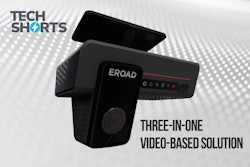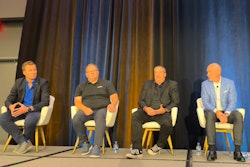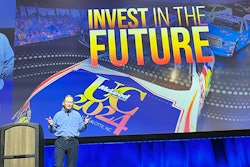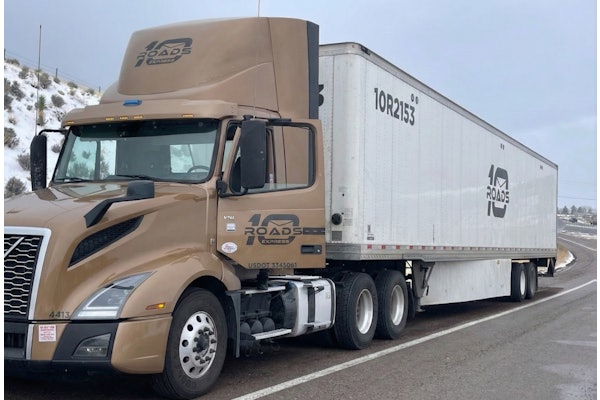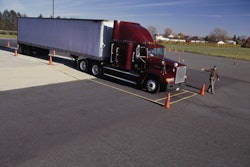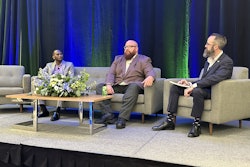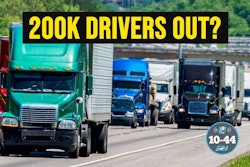Being profitable is any business’s main goal -- you can’t operate without making money. But it’s important in trucking to not lose sight of safety when trying to reap those profits.
Despite efforts by regulators to improve highway safety by mandating electronic logs to cut down on fatigued drivers, truck-involved crashes have continued to rise. Adam Lang with fleet safety tech company Netradyne joins us this week to talk about that trend and what fleets can do about it.
Contents of this video
00:00 10-44 intro
00:26 Driver safety
00:56 Safety and industry associations
03:41 ELDs and hours of service
07:12 Split sleeper berth rule, personal conveyance
09:39 FMCSA potentially revising ELD rules
13:31 Driver facing cameras
17:02 Driver retention
Jason Cannon:
CCJ's 10-44 is brought to you by Chevron Delo heavy-duty diesel engine oil. Now there's even more reasons to choose Delo.
Matt Cole:
White fleets may need to refocus to prioritize safety
Jason Cannon:
You're watching CCJ's 10-44, a weekly episode that brings you the latest trucking industry news and updates from the editors of CCJ. Don't forget to subscribe and hit the bell for notifications so you'll never miss an installment of 10-44.
Hey everybody, welcome back. I'm Jason Cannon and my co-host is Matt Cole. Being profitable in any business, that's the main goal. You can't operate if you don't make money, but it's important in trucking to not lose sight of safety when trying to reap those profits.
Matt Cole:
Despite efforts by regulators to improve highway safety by mandating electronic logs to cut down on fatigue, drivers, truck involved, crashes have continued to rise. Adam Lang with Fleet Safety Tech Company, Dyne joins us this week to talk about that trend and what fleets can do about it.
Adam Lang:
In my previous life, working in risk with a trucking company, I was really, really fortunate because that was my first exposure to trucking. Prior to that, I had about 12 years in human resources, so I was recruited to that company to helping their HR department, and it just kind of snowballed from there. But the company I worked for took a very proactive stance towards safety. They spared no expense for it, and that really made my life and my job that much easier because ownership was behind it. Now, I've met a lot of people from other fleets through captive insurance programs, and I can tell you most of the owners and employees of those companies that are in those captives, at least the ones we were in, are very focused on safety and again, don't really have a lot of issues spending money to do it.
In the name of safety, however, networking with people through industry associations, state associations, you run into people and you hear stories. And the good thing is that the best step that any company can take to improve safety is to join and become involved in an industry association. I mean, I can't tell you Attri Attri actually put a study out last year I believe, about how industry association correlates to safety, crash rate, CSA scores, all that data. And I really believe that has to be true because you meet people that are doing things or have questions and don't know if they're doing something wrong. But then you hear stories about how there's some of those companies that come out of desperation and they talk about maybe the leadership or the ownership of that particular company might not have the money or want to expend the resources in the name of safety. And I always say the same general thing about that, that every expense and every dollar that you spend towards safety tends to get an ROI of some type. And you might not always notate when that ROI occurs because there's no accounting for the accident or the injury that does not happen, but it's there. And most businesses know doing things the right way is not only better ethically to do, but it's better for the bottom line over time.
Jason Cannon:
ELDs have been a hot button issue in trucking since the mandate was first discussed about a decade ago. But Adam says it shouldn't be the ELDs that people are upset about, but the hours of service themselves.
Adam Lang:
I was fortunate again to work for a company the day I walked in the door. That was 2012, and I walked into hr. I didn't walk into safety right away. That took about a year and couple months before I absorbed the safety department as it were. But we had a O BRDs. We had electronic logs that were not connected to the ECM, but were very, they were as accurate as the driver would make them. But here's the thing about those AO BRDs and I miss 'em. I love them because they very rarely malfunction because they weren't connected to as many things. You'd either have to reboot 'em, you'd lose satellite signal, but I understand why they do need to be hooked to the ECM because you can fudge with them. And that was the whole point, to make sure that not only are you saying you're following the hours of service, but that you can prove you're following the hours of service.
It's kind of like your taxes. You can say that you're paying your taxes, but the IRS is going to know for sure if you're paying your taxes or not. So let's just do it. Now, here's, here's the camp that I found myself in. So when we implemented ELDs, we all thought in the safety department, Hey, this isn't going to be too bad because the drivers are going to be used to this. We've been running a BRDs for years and years, and we released ELDs a year before the mandated date to get prepped to see what pitfalls there were all that good stuff to learn and teach ourselves. The drivers adapted to them very quickly because again, they were familiar with the a o BRDs, but there were some nuances that were a little more difficult to accomplish. Just for example, when drivers had to edit logs, there was a bigger process with that.
It was a little more serious. And back office folks couldn't just edit logs. You had to suggest an edit, and then the driver had to accept that edit or not accept that edit. So there was a lot more conversations about hours of service. Now, what I would say is that for any detractors of ELD, and I can understand why they wouldn't like them when they kind of hold you to a standard, but I don't think your fight is with the ELD. I think your fight is with the hours of service. And on that point, I agree.
Matt Cole:
Adam says there are a couple of things the Federal Motor Carrier Safety Administration has done since the ELD mandate that have helped carriers and drivers significantly. He explains what those are after. Word from 10 44 sponsor Chevron lubricants.
Speaker 4:
We serve customers from Birmingham, Alabama to the Gulf Coast, so our people in our trucks are booked solid all day. There is no slack in our schedules. These trucks can't break down. I choose an engine oil that takes care of the number one issue with our engines emissions, so we don't have to worry about DPF Clatting. I choose the engine oil that keeps our trucks hauling. I choose DELO 600 A DF
Adam Lang:
After the ELD mandate when they introduced the split sleeper berth. Oh boy, yeah, that was great with more flexibility with the split sleeper berth, very tickled with that. And it was a confusing measure at first, but once you got it, you got it. And we taught a lot of our drivers how to do it team operations, and we always caution too to drivers, if you don't get it, don't use it. We will teach you, but if you don't get it right away, don't use it because something bad will happen. Like driver goes home and logs off duty instead of at least an eight hour sleeper birth cycle. That two hour break he had before did not technically stop his 14 hour clock, and now he's over his 14. It can be a big mess if you don't do all the steps correctly. So split sleeper birth flexibility was really nice when they'd let you do a seven and three, seven and three eight and two to stop your 14 hour clock.
The other thing that they did was they released more guidance on personal conveyance, which is already a gray, murky area because there's no statutory language about it. They have guidance. So you have to follow guidance. And I will tell you this, during our time, I would say maybe it was at year two or three of the ELD mandate, we decided to change our personal conveyance policy to one where the driver had to call in twenty four seven, didn't matter. We had round the clock support and they had to request PC and the person on the other end of the phone, the administrator was responsible for reviewing the guidance, reviewing our policy, and ensuring that the PC was being used for a legitimate reason. And that was because prior to that, we just did it on good faith with our drivers, and many of them falsified their record of duty status. We wound up with violations on the driver. Violations on our CSA wasn't a good situation. So we had to go back and regulate and kind of tighten the screws a little bit more because 95% of the drivers were doing it perfectly and 5% we're trying to make work deals and get a little bit more out of their day. But I will again come back to this. Your fight is with the hours of service.
Jason Cannon:
FMCSA is planning on potentially revising the ELD rules with a notice of proposed rulemaking around mid next year. Adam has some ideas about what the agency could and should be doing.
Adam Lang:
I believe what they're looking at is a way to get the pre 2000 vehicles hooked to an ELD somehow because right now they're exempted and they've probably got it in their mind from a few bad actors. It only takes a few bad situations and bad actors to make it cross the board bad for everyone, right? And that's unfortunate. So I think they're looking at ways to eliminate the guys that are getting glider kits with 98, 97 engines out of there. I think if it were me, I would really, and I know this sounds corny and it sounds trite, but it makes the most sense to me. This is a grassroots effort. I would go on a whistle stop tour if I was in charge of the F-M-C-S-A and what I would do and where I would go would be the major trucking hubs. I'd probably pick 15 of 'em, and I'd go to Nashville and Milwaukee and Kansas City and Chicago, Atlanta and Jersey.
I would go to the hubs that are getting the most truck traffic, but also maybe have a lot of drivers and trucking companies there. And I would listen. I would listen to what everyone has to say because I think the solution is going to come from the drivers and from the grassroots level. There's a lot of 'em that will of course scream and shout about things that maybe don't make as much sense, but in there are nuggets of truth. We got to listen to the people that are doing the job because it makes the most sense for them. I would again say to the F-M-C-S-A, you got to do more outreach. The administrators that I have met, and I'll give a shout out to Matt Marin from Minnesota, F-M-C-S-A, he is involved. He has come to countless Minnesota Trucking Association meetings. He will pick up his phone and I think he recently got promoted, but he was a great partner and he would listen.
He would take your feedback. He talked to drivers, he talked to safety professionals, he talked to stakeholders. It didn't matter. He looked at it as a partnership, not as him being the heavy, but rather, Hey, if you're doing something wrong, I'd rather you just call me and we talk about it, and I can help you get on the right path. Instead of sending one of my government thugs in there to write you a bunch of citations. That was Matt. Matt was a straight shooter, a very knowledgeable guy, is a straight shooter, knowledgeable guy, and did things the right way. Now, if you're floating the rules, blatantly you were going to get it, but that's what we need as a continued partnership, right? And try to make accessibility to the advanced notice of proposed rulemaking a little bit easier. So maybe drivers can do it through social media and I don't know, maybe they can do it now, but I'm really big on connecting things to apps and social media because the majority of their time when they're not driving, they're going to be on their phone or a computer maybe, but probably their phone. So make it easier for them to articulate what they'd like to see in the rules and give them a voice.
Matt Cole:
When it comes to technology to improve safety on the road, driver facing cameras are becoming more and more common. While many drivers are concerned about privacy, Adam says, Dyne system addresses many of those concerns.
Adam Lang:
Driver facing alerts and driver facing cameras, hot button issue. You've got a lot of people that bring up privacy, and we squash it right away with the enhanced privacy mode that we can run, or our typical privacy mode, which is when the truck is idle for three minutes or more, not moving, or the engine is turned off for more than three minutes, the driver facing camera goes off and it won't turn back on until the truck moves. So the driver has their privacy, whether they're in a sleeper berth or they're in a day cab, it doesn't matter. It's going to function the same way. Now, driver facing is hot button, and I've heard a lot of experienced drivers say, I don't need big brother looking over my shoulder. I just don't need that. And I will understandably empathize with them, but I also ask 'em this.
I say, is it true? And notice how I'm using legal language because I've sat in enough depositions to fire that off. God help me. So I'll say, well, is it true? You're done improving. You can't improve anymore. You're perfect. No, nobody's perfect, right? And the driver will admit that to you even if they're a super trucker. And I'll say, okay, so if you're not perfect, how do you know what you're doing? Right? And how do you know what you're doing wrong? Well, machine's not going to tell me. And I say, you're right, because machines and the machines that we use are about 99% accurate. So there could be a 1% margin of error. So we will put mechanisms in place so you can contest any of the alerts that your company sends you to coach you on, whether it's in person remotely or the system generates coaching session because we have what we like to refer to as virtual coaching or self-coaching, which is frictionless.
It goes to the driver. The driver acknowledges the alerts and attempts to improve, and nobody talks about it because the driver saw their alerts. The administrator can see the driver logged into their app, saw the alerts perfect and self coached. You also have in cab coaching where the device will make noises or talk to you and say, Hey, you're going a little too fast. Maintain a safe distance. You ran a stop sign. It will give a backward looking alert too, just letting a driver know, Hey, you went through a stop sign. So I feel like with driver facing your company is positioning itself better if a catastrophic collision occurs, because you can say, well, our driver was doing everything right, his eyes were moving, his hands were on the wheel, and he was going down the road. So I mean, that is a huge nugget that you can give over to a plaintiff's attorney whenever there's any collision. Now, if the driver was doing something wrong, it can be bad, and the best thing to do is to own up to it and make it right as best as you can if the driver is doing something wrong.
Jason Cannon:
Driver retention is a concern for many fleets, and Adam has some advice when fleets start rolling out and using those in-cab cameras.
Adam Lang:
First off, when you roll out the technology, don't surprise the drivers. Let them know in advance that you're looking at cameras and it's 2024. It's not like 20 17, 20 16 when there were way less cameras out there. These drivers know that cameras are eventually going to make their way into every vehicle, right? Be honest with them, level with them. Let them know what you're looking at. Ask a driver if they want be, if they're interested in a pilot. If you're going to pilot different systems, such Nero or one of our competitors, ask your fleet, and I would say, go to your most vocal harshest critics because they're the ones that are going to teach you the most. It used to be frustrating for some of my team members because they'd say, these guys are outspoken, and they're always in here every week. And I'm like, those are the folks we need to talk to.
The people that don't say anything, they're not giving you their opinion, so we don't know where they stand. The drivers that do give you their opinion, work with them and win them over. Get them on the camera system if you can. But I would say gradual rollout. A lot of communication. Get their questions. If you can't answer their questions, be honest. Tell them you can't, and talk to the company and see if the company, the vendor can answer those questions. Involve the vendor in your rollout. Have the vendor come to your driver safety meetings, have 'em come to your company. Learn about the culture. It's a very important process and reine willing to do that. We're willing to come on site, roll talk with your drivers. Our field engineers will work with your shop, your installers. We're ready to put cameras in there for everyone's safety.
So involve the drivers. Be gradual with it. Let's gather some data first for a little bit of time, and then let the fleet know how they're doing. Hey, we've got a lot of distracted driving or a lot of speeding, and this is what we're going to work on once we start coaching. And once you kind of run down the clock on when you say you're not going to actively coach the drivers, flip the switch, turn on the end cab alerts, let the Inca alerts coach the drivers, watch your scores and make sure that they're rising, they're going in the right direction. And then after that, turn on virtual coaching. Let the system send them alerts that you choose and let them kind of go through that, see if scores improve further, and then start doing manage coaching. Those are the coaching sessions where you're pulling the driver in or you're having a conversation remotely while they're stopped and not driving.
And you talk about the alerts. You talk about what type of things you've seen, and never, ever, ever forget the positive that they're doing, because our system allows you to see the driver stars, which are positive alerts, several different kinds. Even if a driver doesn't trigger any driver stars in a driving day, it still calculates their green zone minutes or green minutes, which means all the minutes they drove where they weren't having an alert and they weren't doing anything bad or risky. So you can always say, yeah, you had several alerts, but 55% of your day, you're in the green minute category, which is good. So we just have to work on 45%. That's easy. We can do that. Keep it positive.
Jason Cannon:
That's it for this week's 10-44. You can read more on ccjdigital.com. While you're there, sign up for our newsletter and stay up to date on the latest in trucking industry news and trends. If you have any questions or feedback, please let us know in the comments below. Don't forget to subscribe and hit the bell for notifications so you can catch us again next week.


